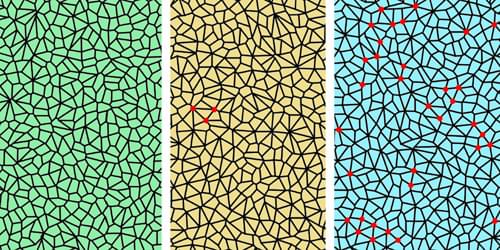A dynamical tension model captures how cells swap places with their neighbors in epithelial tissues, explaining observed phase transitions and cellular architectures.
Epithelial tissues line the surfaces of every organ in our bodies. In the earliest stages of organ development and in wound healing, the cells that make up these simple sheets constantly rearrange themselves, exchanging positions like molecules in a liquid. But this fluidization is often hindered by the formation of multicell clusters, whose origins remain unclear. Using a dynamical structural model, Fernanda Pérez-Verdugo and Shiladitya Banerjee of Carnegie Mellon University in Pennsylvania now identify the mechanical prerequisites that lead to the formation and dissolution of these stabilized clusters [1]. They show how dynamic feedback between tension and strain controls the tissue’s material properties.
Existing models of tissue fluidity treat epithelial tissues as foam-like, polygonal networks of cells whose edges join at triple points. However, these models fail to explain the mechanisms underpinning cell neighbor exchanges. In particular, they oversimplify such exchanges by treating them as an instantaneous process, thereby avoiding the impact of exchanges that stall midprocess. One resulting discrepancy with experimental results is the absence of stable “rosette” structures that are observed in developing tissues where four or more cells meet.
